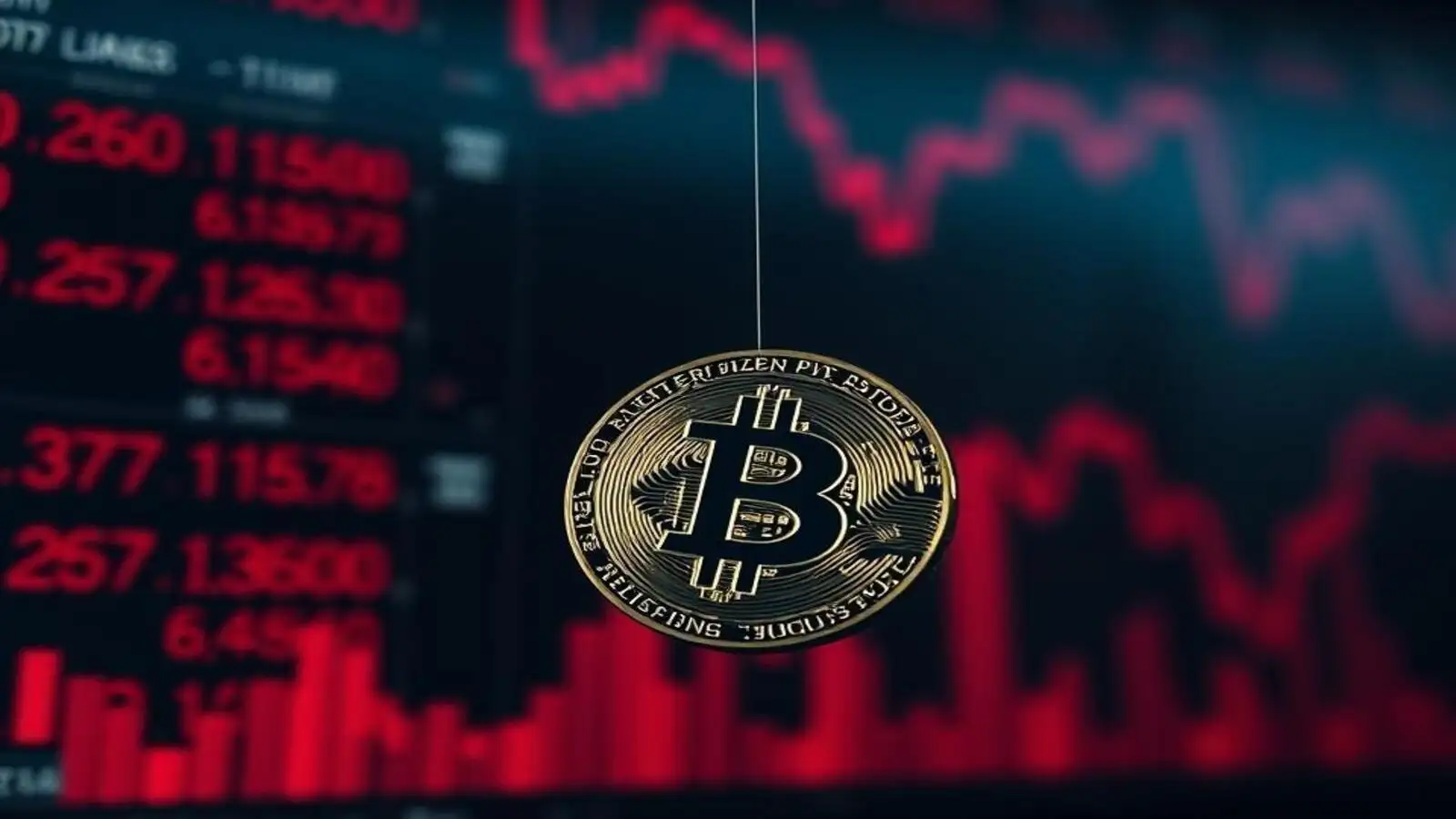The cryptocurrency market witnessed a significant technical development in mid-November 2025 when Bitcoin formed what traders call a “death cross,” a pattern that has historically signaled potential bearish momentum in financial markets. On November 16, 2025, Bitcoin’s 50-day moving average crossed below its 200-day moving average, marking this ominous technical milestone at a time when the digital asset was trading around $93,000. This crossover arrived approximately six weeks after Bitcoin achieved a historic peak near $126,000 on October 6, representing a remarkable culmination of the 2024-2025 bull run.
The formation of a death cross typically indicates that short-term price momentum has deteriorated relative to longer-term trends, suggesting that selling pressure has intensified over recent trading sessions. However, technical analysts and cryptocurrency veterans caution that death crosses function as lagging indicators rather than predictive tools, often materializing after substantial price declines have already occurred. In Bitcoin’s unique market structure, previous death cross formations during this cycle actually coincided with local price bottoms rather than the beginning of extended bear markets, challenging conventional interpretations of this technical signal.
Build the future you deserve. Get started with our top-tier Online courses: ACCA, HESI A2, ATI TEAS 7, HESI EXIT, NCLEX-RN, NCLEX-PN, and Financial Literacy. Let Serrari Ed guide your path to success. Enroll today.
Understanding the Death Cross: Technical Signal or Market Noise?
A death cross represents one of the most widely recognized bearish patterns in technical analysis, occurring when a shorter-term moving average crosses beneath a longer-term moving average. In Bitcoin’s case, the 50-day simple moving average fell below the 200-day simple moving average on November 16, while the spot price hovered near $93,000 on major exchanges. This pattern suggests that the average price over the past 50 days has declined below the average price over the past 200 days, indicating a shift in market momentum from bullish to bearish.
Technical traders monitor this crossover because it reflects changing market dynamics. When short-term averages fall below long-term averages, it demonstrates that recent selling pressure has been sufficient to drag down the near-term price trajectory below the established long-term trend. The visual representation on price charts shows the 50-day line descending through the 200-day line, creating a cross pattern that has earned its foreboding name.
However, the predictive value of death crosses remains hotly debated among market participants. Comprehensive data analysis by cryptocurrency analyst Mario Nawfal reveals that Bitcoin’s historical response to death cross formations has been far from uniform. Over the past decade, price performance in the first three weeks following a death cross has been essentially random, with gains and losses occurring in roughly equal measure. Looking at longer timeframes of two to three months post-crossover, average recoveries have ranged between 15% and 26%, suggesting that death crosses often mark capitulation points rather than the beginning of sustained downtrends.
Some previous cycle death crosses preceded powerful rallies that ultimately pushed Bitcoin to new all-time highs, while others did indeed signal the onset of prolonged bear markets. The 2018 death cross, for instance, occurred during the brutal cryptocurrency winter and was followed by an additional 65% decline over subsequent months. Conversely, death crosses in 2019 and early 2020 marked excellent accumulation zones for long-term investors, with Bitcoin subsequently rallying hundreds of percent from those levels.
The 2025 Correction: A 25% Plunge from Record Highs
The current death cross formation follows a sharp 25% correction from Bitcoin’s October 6 peak of $126,000, representing one of the steepest drawdowns in this cycle. The selloff accelerated dramatically in mid-November, with Bitcoin plummeting from approximately $107,500 on November 11 to an intraday low near $89,000, erasing all year-to-date gains accumulated through patient accumulation and institutional adoption. The speed and magnitude of this decline sent shockwaves through cryptocurrency markets, with altcoins experiencing even more severe drawdowns.
When compared to the April 2025 correction, which saw Bitcoin lose 30% over a 79-day period, the current pullback appears slightly less severe in magnitude but more compressed in duration. The April correction was characterized by gradual erosion of support levels and steady distribution, while the November selloff featured multiple capitulation events with large single-day declines exceeding 8%. This difference in character has important implications for market structure and potential recovery patterns.
The psychological impact of this correction cannot be overstated. The Crypto Fear and Greed Index, which aggregates volatility, market momentum, social media sentiment, and other factors, plunged into “extreme fear” territory as Bitcoin broke below the psychologically important $90,000 level. Technical indicators across multiple timeframes flashed oversold readings, with the Relative Strength Index (RSI) on daily charts dropping below 30, a threshold typically associated with short-term capitulation and potential reversal zones.
Market participants who had grown accustomed to Bitcoin’s seemingly unstoppable ascent through 2024 and early 2025 found themselves confronting the reality of cryptocurrency volatility. Leveraged positions were liquidated en masse, with derivatives exchanges reporting over $2.5 billion in liquidations during the peak of the selloff. Long positions that had accumulated during the rally to $126,000 were forcibly closed as prices cascaded through key support levels, creating a self-reinforcing cycle of selling pressure.
Macro Headwinds: Federal Reserve Policy and the Strengthening Dollar
While technical factors and market structure played important roles in Bitcoin’s correction, macroeconomic developments provided the fundamental backdrop for the selloff. The Federal Reserve’s increasingly hawkish posture on interest rates emerged as a primary catalyst for risk asset repricing across global markets. Fed Chair Jerome Powell’s comments in early November suggested that the central bank was in no hurry to cut interest rates, citing persistent inflation in certain sectors and a resilient labor market that could withstand higher borrowing costs for an extended period.
This shift in Federal Reserve communication reduced market expectations for interest rate cuts in the first half of 2026, with fed funds futures pricing now implying fewer than two quarter-point reductions over the next twelve months. Higher interest rates increase the opportunity cost of holding non-yielding assets like Bitcoin, as investors can now earn attractive returns from Treasury bills, money market funds, and other fixed-income instruments with minimal risk. The risk-free rate, as proxied by short-term Treasury yields, climbed above 4.5%, making the volatility and uncertainty associated with cryptocurrency investments less appealing on a risk-adjusted basis.
The strengthening U.S. dollar, which typically moves inversely to Bitcoin and other commodities, gained significant ground against major currencies throughout November. The Dollar Index (DXY), which measures the greenback against a basket of peer currencies, rose above 106, reaching levels not seen since early 2024. A stronger dollar makes Bitcoin more expensive for international buyers and tends to pressure dollar-denominated assets, as global liquidity conditions tighten and capital flows back toward U.S. markets.
Broader risk appetite deteriorated across asset classes as investors rotated away from speculative growth investments toward defensive positions. Technology stocks, particularly those without strong earnings or cash flow, experienced sharp declines. The Nasdaq Composite, which often correlates with Bitcoin due to shared investor bases and similar risk profiles, fell approximately 8% from its November highs. This correlation between Bitcoin and traditional risk assets has strengthened considerably since the introduction of spot Bitcoin ETFs, as institutional investors now treat cryptocurrency as another allocation within their alternative investment portfolios.
One decision can change your entire career. Take that step with our Online courses in ACCA, HESI A2, ATI TEAS 7, HESI EXIT, NCLEX-RN, NCLEX-PN, and Financial Literacy. Join Serrari Ed and start building your brighter future today.
Bitcoin ETF Outflows: Institutional Demand Weakens
One of the most significant developments during Bitcoin’s correction was the dramatic shift in U.S. spot Bitcoin ETF flows. After experiencing record inflows throughout early 2025 as institutional investors embraced newly approved investment vehicles, Bitcoin ETFs encountered their first sustained period of redemptions. BlackRock’s iShares Bitcoin Trust (IBIT), the largest Bitcoin ETF by assets under management, recorded $1.26 billion in net outflows during mid-November alone, representing a stark reversal from the multi-billion dollar inflows that characterized the fund’s early months.
The aggregate outflows across all spot Bitcoin ETFs exceeded $3 billion during the correction, marking the most significant redemption event since these products launched in January 2024. Fidelity’s Wise Origin Bitcoin Fund (FBTC), Grayscale’s Bitcoin Trust (GBTC), and other major offerings all experienced net redemptions as investors reduced cryptocurrency exposure. These outflows occurred despite Bitcoin’s price falling to levels that many analysts considered attractive entry points, suggesting that institutional sentiment had shifted meaningfully.
ETF demand patterns provide crucial insights into institutional investor behavior because these vehicles represent the primary method through which traditional financial institutions, pension funds, and registered investment advisors gain Bitcoin exposure. Unlike direct cryptocurrency purchases, which require custody solutions, wallet management, and operational infrastructure, ETFs allow institutions to trade Bitcoin through standard brokerage accounts with familiar regulatory protections.
The weakening of ETF demand created additional downward pressure on Bitcoin’s price through multiple channels. ETF issuers must adjust their Bitcoin holdings to match share creation and redemption activity, meaning that sustained outflows forced authorized participants to sell Bitcoin in the spot market to return capital to redeeming shareholders. This selling pressure amplified the technical breakdown and contributed to the formation of the death cross by pushing short-term moving averages lower.
Market liquidity also deteriorated as ETF trading volumes declined. During the height of Bitcoin’s rally, daily ETF trading volumes frequently exceeded $5 billion, providing deep markets and tight bid-ask spreads. As volumes contracted to below $2 billion on some days during the correction, price discovery became less efficient and volatility increased. Thinner markets meant that large orders could move prices more dramatically, exacerbating intraday swings and creating challenging conditions for institutional traders accustomed to liquid markets.
Long-Term Holders Take Profits: On-Chain Data Reveals Distribution
Blockchain analytics provided additional context for Bitcoin’s correction by revealing significant distribution from long-term holders who had accumulated Bitcoin during previous cycles. On-chain data from Glassnode and CryptoQuant showed that wallets containing Bitcoin acquired before 2023 initiated substantial selling activity as prices approached $120,000 in early October. These long-term holders, who had weathered the 2022 bear market and held through subsequent volatility, began realizing profits after achieving gains exceeding 200% from their cost bases.
The behavior of long-term holders serves as an important market indicator because this cohort typically demonstrates strong conviction and lower sensitivity to short-term price fluctuations. When long-term holders begin distributing meaningfully, it often signals that smart money perceives current valuations as attractive selling opportunities. Conversely, when long-term holders accumulate aggressively, it frequently precedes major rallies as supply is removed from circulation.
Data on exchange inflows confirmed that long-term holders were moving previously dormant Bitcoin to trading platforms. Coins that had remained unmoved for 12+ months began appearing in exchange wallets, suggesting that holders were preparing to sell or had already executed sales. The volume of Bitcoin moving from cold storage to exchanges increased by approximately 35% during October and early November, providing a supply overhang that absorbed buying pressure.
This distribution pattern differs from the panic selling that characterizes blow-off tops and market crashes. Long-term holders generally sell into strength rather than weakness, aiming to maximize their realized gains by exiting positions during periods of high demand and liquidity. The gradual nature of their distribution throughout October and November suggests profit-taking rather than capitulation, indicating that this cohort expects to have opportunities to reaccumulate at lower prices.
The supply dynamics created by long-term holder distribution intersected with weakening ETF demand to create unfavorable conditions for Bitcoin’s price. As sophisticated holders sold into rallies, institutional buyers who had driven the advance to $126,000 stepped away from the market. This supply-demand imbalance overwhelmed short-term speculative buying and initiated the correction that ultimately generated the death cross formation.
Historical Context: Why This Time Might Be Different
While death crosses have appeared regularly throughout Bitcoin’s history, several factors distinguish the current formation from previous instances. The maturation of cryptocurrency markets through ETF adoption, derivatives instruments, and institutional infrastructure has fundamentally altered Bitcoin’s price discovery mechanisms and correlation patterns. Bitcoin now trades more like a traditional risk asset, exhibiting stronger correlations with equity indices and responding more directly to macroeconomic developments.
Previous death crosses occurred in markets dominated by retail speculation, exchange manipulation, and thin liquidity that produced extreme volatility in both directions. The current market structure features significantly deeper liquidity, professional market makers, and institutional participation that dampens volatility somewhat while potentially extending trend durations. This suggests that both rallies and corrections may develop more gradually than in previous cycles, with fewer dramatic reversals and more sustained directional moves.
The regulatory environment has also evolved considerably since earlier death cross formations. Bitcoin ETF approval represented a watershed moment for cryptocurrency legitimacy, providing regulatory clarity and enabling mainstream adoption. However, this institutional integration also means that Bitcoin faces more direct exposure to traditional finance headwinds, including central bank policy, institutional risk management, and broader market sentiment.
Another distinguishing factor is Bitcoin’s increasing correlation with macroeconomic variables. In earlier cycles, Bitcoin often moved independently of traditional markets, driven primarily by cryptocurrency-specific catalysts like exchange hacks, regulatory announcements, or technological developments. The current environment sees Bitcoin responding more directly to Federal Reserve communications, inflation data, and geopolitical events, suggesting that macro factors will play an increasingly important role in determining price direction.
What Comes Next: Scenarios and Considerations for Investors
As Bitcoin navigates the aftermath of its death cross formation, market participants are evaluating multiple scenarios for how the correction might resolve. Historical precedent suggests that death crosses have marked both major turning points and interim pauses within larger trends, making definitive predictions challenging.
The bullish case argues that the current correction represents a healthy consolidation following Bitcoin’s explosive rally from below $60,000 in late 2024 to $126,000 in October 2025. From this perspective, the death cross and associated technical damage have created oversold conditions that will resolve to the upside once macro headwinds ease and institutional demand stabilizes. Proponents note that Bitcoin’s long-term fundamentals remain intact, with growing adoption, improving infrastructure, and constrained supply supporting higher valuations over time.
The bearish case contends that Bitcoin’s rally to $126,000 represented speculative excess driven by ETF hype and that a more substantial correction is necessary to establish a sustainable foundation for the next advance. This view emphasizes that death crosses often precede extended consolidation periods where Bitcoin trades in a wide range, frustrating both bulls and bears while digesting previous gains. Persistent macro headwinds, including higher-for-longer interest rates and strong dollar dynamics, could prevent Bitcoin from mounting a sustained recovery in the near term.
A middle scenario suggests that Bitcoin will stabilize in a range between $85,000 and $100,000 while digesting recent volatility and waiting for clearer macro catalysts. This outcome would mirror consolidation periods following previous major rallies, where Bitcoin spent several months building a base before resuming its uptrend. Range-bound trading would allow overleveraged positions to be cleared, sentiment to reset, and new buyers to accumulate positions at more attractive valuations.
For long-term investors, the current correction offers a reminder of Bitcoin’s inherent volatility and the importance of position sizing, risk management, and emotional discipline. Those with longer time horizons may view current levels as attractive accumulation opportunities, particularly if they believe in Bitcoin’s value proposition as digital gold and its potential role in future financial systems. However, near-term traders face a more complex environment where technical damage, weakening momentum, and macro uncertainty create elevated risk.
Conclusion: Navigating Uncertainty in Evolving Markets
Bitcoin’s death cross formation on November 16, 2025, represents a significant technical development that has focused attention on the sustainability of cryptocurrency valuations following a historic rally. The 25% correction from October highs, combined with record ETF outflows, long-term holder distribution, and challenging macro conditions, has created a more uncertain outlook than existed during Bitcoin’s ascent to $126,000.
However, historical analysis of previous death crosses reveals that these formations have produced highly variable outcomes, sometimes marking excellent entry points and other times preceding further declines. The current market structure, characterized by institutional participation, regulatory clarity, and deeper liquidity, may produce different dynamics than earlier cycles, making historical comparisons less reliable.
As Bitcoin trades in the aftermath of this technical breakdown, investors must weigh the long-term potential of cryptocurrency adoption against near-term headwinds from monetary policy, market structure, and sentiment. The resolution of this correction will provide important insights into how mature cryptocurrency markets respond to adversity and whether Bitcoin can maintain its position as a compelling alternative asset in an increasingly complex global financial system.
Whether the death cross proves prescient or premature will ultimately depend on factors that extend beyond technical analysis—including Federal Reserve policy evolution, institutional investment flows, regulatory developments, and Bitcoin’s continued adoption as both a speculative asset and potential store of value. For now, market participants remain divided on whether current levels represent an attractive entry point or simply a pause in a longer journey lower.
Ready to take your career to the next level? Join our Online courses: ACCA, HESI A2, ATI TEAS 7 , HESI EXIT , NCLEX – RN and NCLEX – PN, Financial Literacy!🌟 Dive into a world of opportunities and empower yourself for success. Explore more at Serrari Ed and start your exciting journey today! ✨
Track GDP, Inflation and Central Bank rates for top African markets with Serrari’s comparator tool.
See today’s Treasury bonds and Money market funds movement across financial service providers in Kenya, using Serrari’s comparator tools.
Photo source: Google
By: Montel Kamau
Serrari Financial Analyst
25th November, 2025
Article, Financial and News Disclaimer
The Value of a Financial Advisor
While this article offers valuable insights, it is essential to recognize that personal finance can be highly complex and unique to each individual. A financial advisor provides professional expertise and personalized guidance to help you make well-informed decisions tailored to your specific circumstances and goals.
Beyond offering knowledge, a financial advisor serves as a trusted partner to help you stay disciplined, avoid common pitfalls, and remain focused on your long-term objectives. Their perspective and experience can complement your own efforts, enhancing your financial well-being and ensuring a more confident approach to managing your finances.
Disclaimer: This article is for informational purposes only and does not constitute financial advice. Readers are encouraged to consult a licensed financial advisor to obtain guidance specific to their financial situation.
Article and News Disclaimer
The information provided on www.serrarigroup.com is for general informational purposes only. While we strive to keep the information up to date and accurate, we make no representations or warranties of any kind, express or implied, about the completeness, accuracy, reliability, suitability, or availability with respect to the website or the information, products, services, or related graphics contained on the website for any purpose. Any reliance you place on such information is therefore strictly at your own risk.
www.serrarigroup.com is not responsible for any errors or omissions, or for the results obtained from the use of this information. All information on the website is provided on an as-is basis, with no guarantee of completeness, accuracy, timeliness, or of the results obtained from the use of this information, and without warranty of any kind, express or implied, including but not limited to warranties of performance, merchantability, and fitness for a particular purpose.
In no event will www.serrarigroup.com be liable to you or anyone else for any decision made or action taken in reliance on the information provided on the website or for any consequential, special, or similar damages, even if advised of the possibility of such damages.
The articles, news, and information presented on www.serrarigroup.com reflect the opinions of the respective authors and contributors and do not necessarily represent the views of the website or its management. Any views or opinions expressed are solely those of the individual authors and do not represent the website's views or opinions as a whole.
The content on www.serrarigroup.com may include links to external websites, which are provided for convenience and informational purposes only. We have no control over the nature, content, and availability of those sites. The inclusion of any links does not necessarily imply a recommendation or endorsement of the views expressed within them.
Every effort is made to keep the website up and running smoothly. However, www.serrarigroup.com takes no responsibility for, and will not be liable for, the website being temporarily unavailable due to technical issues beyond our control.
Please note that laws, regulations, and information can change rapidly, and we advise you to conduct further research and seek professional advice when necessary.
By using www.serrarigroup.com, you agree to this disclaimer and its terms. If you do not agree with this disclaimer, please do not use the website.
www.serrarigroup.com, reserves the right to update, modify, or remove any part of this disclaimer without prior notice. It is your responsibility to review this disclaimer periodically for changes.
Serrari Group 2025












